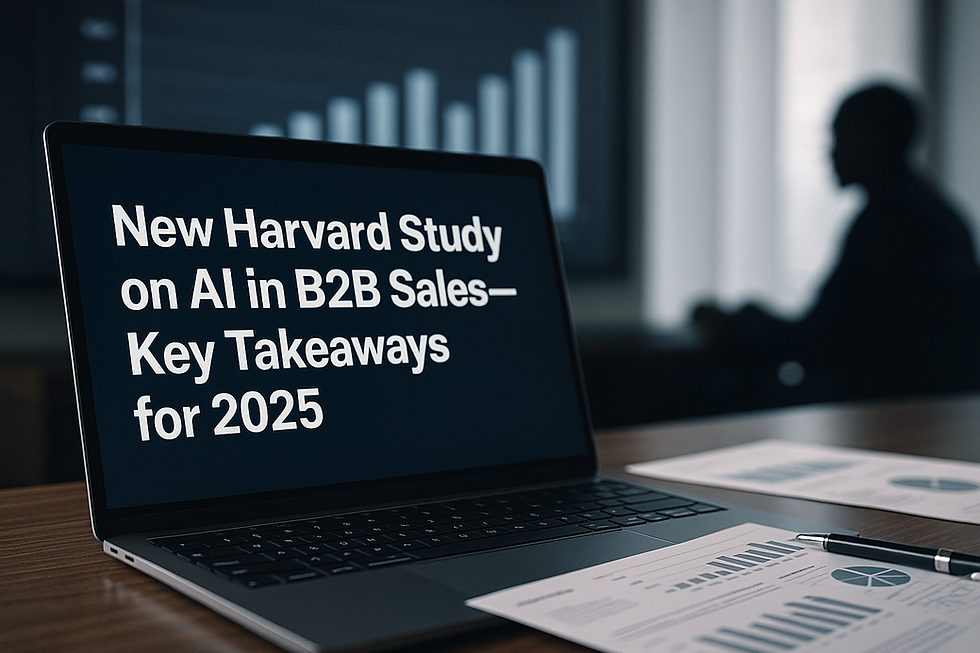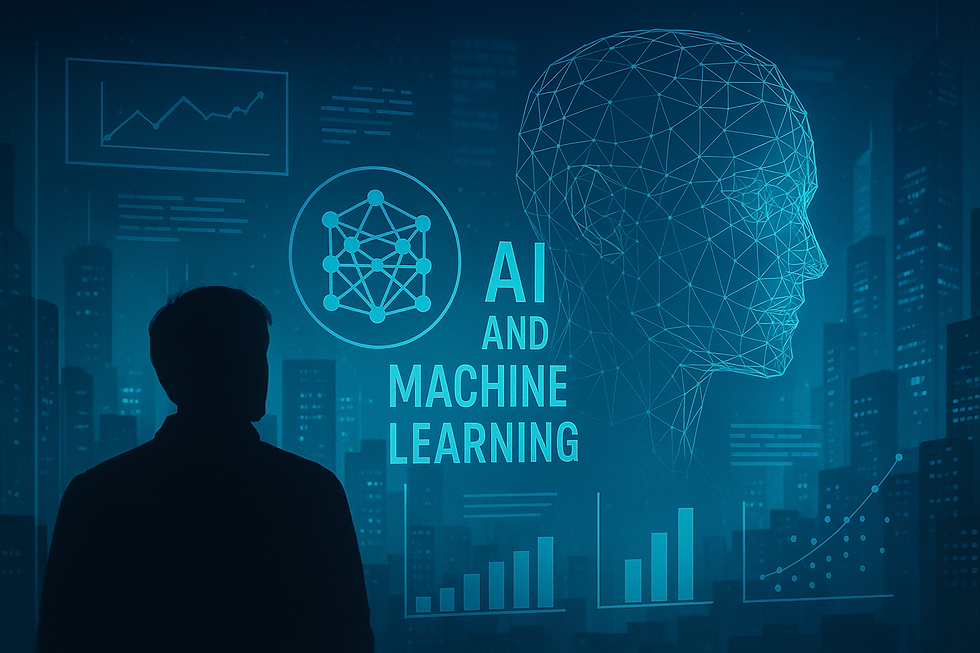New Harvard Study on AI in B2B Sales—Key Takeaways for 2025
- Muiz As-Siddeeqi

- Aug 23
- 5 min read

New Harvard Study on AI in B2B Sales—Key Takeaways for 2025
What Harvard actually published that B2B sellers can use right now
In March 2025, Sunil Gupta and Frank V. Cespedes analyzed SAP’s sales transformation and gave us concrete, verifiable outcomes. SAP mapped its end-to-end customer journey and deployed more than 40 AI tools across selling motions. The result was a cut in sales cycle time—from 12–18 months down to 3–6 months—and support for over 22,000 new customer opportunities in 2024. That is not a theoretical uplift; it is an operating model change with documented throughput and cycle metrics—flagship evidence in the Harvard AI in B2B sales 2025 discussion.
In June 2025, HBR highlighted how decision-making in sales and marketing has shifted from slow and reflective to fast and “reflexive,” powered by real-time data and AI nudges. The practical implication is that reps, managers, and revenue leaders are moving from weekly reviews to in-flow, moment-to-moment adjustments.
Harvard’s community also contributed evidence on adjacent capabilities your B2B team depends on. A revised Harvard Business School working paper showed how large language models can augment market research workflows, sharpening segmentation and message testing—inputs that directly feed ABM, pricing, and territory design.
And beyond single cases, outside validation is lining up with the Harvard narrative. McKinsey’s 2025 global AI survey reports a bigger share of companies are now seeing revenue increases in the business units actually using GenAI, with marketing and sales among the top value pools; its 2024 survey already documented that GenAI adoption more than doubled in marketing and sales year over year. This is no longer a lab story—it’s a P&L story.
Finally, research by BCG (with Harvard Business School collaborators) finds GenAI adoption can lift output quality by about 40 percent while speeding work by roughly 25 percent—useful bounds for your 2025 business cases.
Bonus: Machine Learning in Sales: The Ultimate Guide to Transforming Revenue with Real-Time Intelligence
The 9 patterns we’re taking to the bank in 2025
Map the journey first, wire AI second
SAP’s results came from mapping where value leaks were happening, then instrumenting those exact touchpoints with AI—lead triage, product discovery, pricing guidance, content, and outreach—rather than sprinkling bots everywhere. Treat the customer journey as a process design problem, not a tool catalog.
Shorter cycles come from orchestration, not one killer app
Forty plus tools sounds like overkill until you realize each one removed friction at a different step—data enrichment, qualification, demo prep, proposal drafting, legal review. The cycle-time cut at SAP wasn’t magic; it was compounding seconds and hours saved across the path to purchase.
Real-time beats rear-view
Harvard’s June 2025 take is clear: teams that update assignments, plays, and talk tracks in the flow of work outperform ones that wait for QBRs. Put differently, your CRM plus AI should behave like a live air-traffic system, not a monthly report generator.
Market research just got hands and feet
HBS research on using LLMs for market research shows why many B2B teams can now run iterative message tests, persona synthesis, and competitive landscaping weekly instead of quarterly. The trick is building review loops so human judgment stays in charge of targeting and claims.
Adoption is broadening and revenue impact is now measurable
Across industries, more respondents report actual revenue increases from GenAI use cases in the units that use them. If your CFO asked “Where’s the money,” 2025 finally has better answers than pilot anecdotes.
Quality and speed move together
The BCG–HBS findings are a useful planning anchor: expect on the order of 25 percent faster output when GenAI is woven into real workflows, with higher quality work product to boot—if governance and prompts are structured.
Sales managers matter more than models
Harvard’s sales scholarship has hammered this for years: tools do not fix misaligned territories, incentives, or coaching gaps. AI adds leverage, but front-line management cadence still mediates performance. If managers do not reinforce new workflows, AI ROI fades.
B2B wins come from data quality, not just model choice
McKinsey’s 2025 readout points to teams “rewiring” work and raising data standards. We see the same in Harvard’s guidance: clean interaction data, governed content repositories, and defined taxonomies are the hidden engines of top-quartile outcomes.
Case depth beats tool breadth
The SAP example shows a bias to depth—instrument the segments where you can see the whole journey, then expand. That’s the opposite of buying five vendors for five problems on day one.
Translate the Harvard signals into a 2025 B2B playbook
Pipeline creation
Use LLM-assisted market research to spot “look-alike” accounts and micro-segments in days, not months; have humans validate the clusters before campaigns go live.
Pair enrichment plus routing rules so the best opportunities hit the right rep within minutes, with pre-filled context and first-message drafts. Harvard’s reflexive-decision framing is your cue to cut handoffs.
Discovery and demo
Generate call plans that blend product knowledge with industry-specific pain points sourced from your content library. Maintain a red-team prompt that flags ungrounded claims before decks ship.
Pricing and proposals
Train assistants on win-loss data and approved language so proposals are both on-brand and evidence-based. Measure time-to-proposal and revision counts as primary KPIs, echoing the SAP focus on cycle compression.
Forecasting and coaching
Shift from static forecasts to in-flight probability updates that factor contact graph changes, email sentiment, and meeting density. Coach off the deltas in-week rather than post-mortems in-quarter.
Metrics that match what Harvard’s evidence implies
Cycle time by segment and deal band
If SAP can halve enterprise cycles by orchestrating tools across the journey, you can benchmark cycle time quarter-on-quarter where you’ve wired similar steps.
Opportunity creation per rep hour
Document pre-AI and post-AI throughput. If assistants are really taking research and drafting time down, you should see a visible slope change.
Proposal latency and revision churn
The fastest proxy for real decision-support is how quickly high-quality proposals ship and how many revisions they need.
Data fitness score
Borrow from McKinsey’s “rewiring” language and keep a live scorecard of field completeness, taxonomy adherence, and duplicate rates. AI that sits on messy data underdelivers.
Where teams stumble—and the Harvard-aligned fixes
Stumble 1: Buying tools before mapping the work
Fix: Start with a journey map, then instrument the two or three biggest bottlenecks. This is how SAP’s outcomes became measurable instead of anecdotal.
Stumble 2: Weekly reviews, monthly hygiene
Fix: Move to “reflexive” operating rhythm—dashboards that refresh continuously, triggers that route tasks instantly, and 1:1s that focus on what changed in the last 48 hours.
Stumble 3: Treating LLMs as idea machines, not research accelerators
Fix: Put LLMs to work on source gathering, summarization, and synthesis with human verification—exactly the use case HBS research explored.
Tooling that lines up with the research
A governed content hub so assistants only use approved claims and case quotes.
A routing engine that reacts to account signals within minutes, not days.
An experimentation layer to A/B test talk tracks, email copy, and pricing notes—then freeze the winners into playbooks.
A data quality pipeline that monitors field completeness and auto-flags junk before it pollutes forecasts. These are the “rewiring” moves linked to revenue impact in 2025 surveys.
If you need a one-page plan for the next 90 days
Week 1–2
Map the current enterprise or upper-midmarket journey. Identify the two biggest sources of delay. Assign a metric owner for each delay.
Week 3–6
Instrument those delays. For example, deploy an LLM research assistant to prep briefs for top 100 accounts and auto-draft first outreach; add real-time routing rules for high-intent signals.
Week 7–10
Measure cycle time, proposal latency, and win-rate delta on the targeted segments. Lock in the working prompts, freeze the playbook, and expand to the next segment.
Closing thought we wish we’d heard sooner
What Harvard’s latest work does better than most is translate “AI potential” into operations. When a blue-chip B2B company shrinks cycles by months after rewiring its journey with dozens of tightly scoped AI tools, that’s not a demo. That’s a template. Combine that with evidence that more firms now see revenue impact in the units using GenAI, and 2025 stops being a year of pilots and becomes a year of process.






Comments